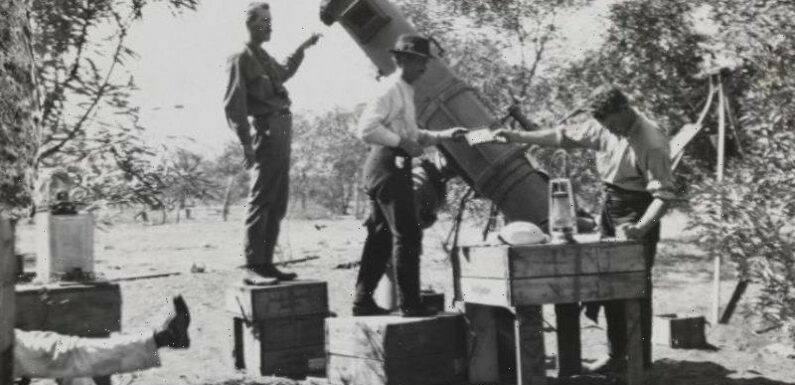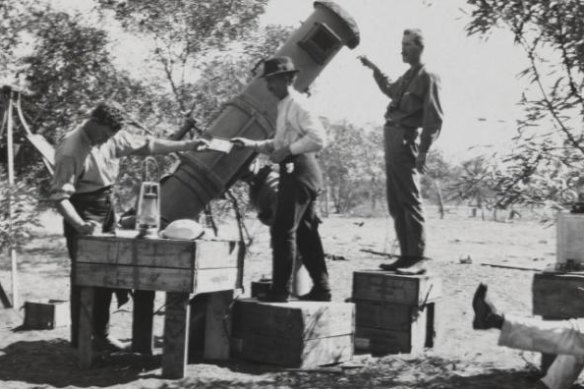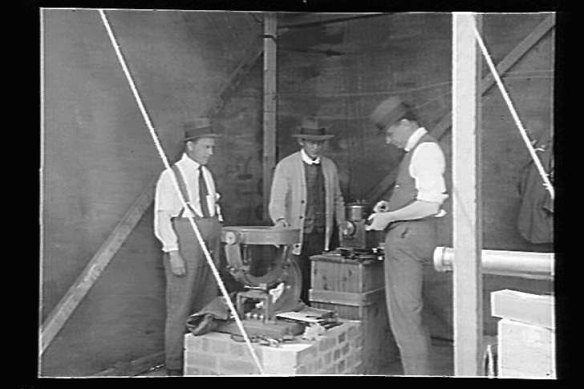
First published in The Age on September 22, 1922
THE ECLIPSE OF THE SUN
Ideal Conditions at Wallal
Observations Highly Successful
Great Event Described
Wallal Downs Station, a remote station 300 kilometres south of Broome on Eighty Mile Beach, was deemed the most ideal place on Earth to view a total eclipse of the Sun.Credit:Museum of Western Australia
Wallal – the eclipse was observed at Wallal under perfect conditions, and all the observations were carried through successfully. On Wednesday night the astronomers had a strenuous time making final preparations for the great event, and dawn found them still at work, standardising the plates for the delicate photographic measurements which were to be made by the 10-feet camera on the corona. Day broke perfectly, the sky being absolutely cloudless, and the air calm and still. The astronomers were engaged during the morning putting the final touches to the instruments, to make sure that there would be no hitch. At 9.30 am a small very thin cloud was observed near the sun, but this was rapidly dissolved. At noon all eyes were turned to the sun, to watch for the first contact, when the moon would start to bite into the disc of the sun.
At three minutes past 12 the first indentation on the sun’s edge was noticed on the north-west quadrant. After this the moon’s disc could be observed moving over the sun, blotting out its light bit by bit. It was not until half an hour after the first contact that any change could be noticed in the general illumination, and then the light began to fall off rapidly.
At 12.50 pm the sky about the horizon began to darken rapidly in colour, and this dark colour spread gradually up to the region of the partially eclipsed sun until just before totality the landscape wore an appearance as though a storm were lowering over it, and the sky had a deep indigo tint. An image of the crescent of the partially eclipsed sun could be seen under every tree and under every small hole, spaces between leaves acting as a pinhole camera. At 1.10 pm Venus appeared as a brilliant star, high up in the east, and five minutes later it was possible to see Jupiter.
Solar eclipse expedition, Goondiwindi, Queensland. The expedition was led by Joseph Baldwin, Government Astronomer, Melbourne Observatory.Credit:Museum of Victoria
At 1.15 pm, all hands took up their eclipse stations, and started preparing instruments for observation. The timekeeper gave warning calls from the chronometer at ten minutes, six minutes, two minutes and thirty seconds before totality commenced. When the sun disappeared the solar corona shot forth around the dark case of the moon, and it was indeed a sight beautiful to behold.
Professor Chant and Dr Young, who were both at the 1918 eclipse in Colorado, think this eclipse was a dark eclipse. This opinion was shared by Dr Evershed, who had been at four previous eclipses. Dr Campbell and Dr Trampler were both gratified with the success with which the exposures of the Einstein plate was carried through. Dr Campbell says that the image of the star used in guiding for the Einstein cameras showed that the atmosphere was tranquil. He shall have a very few of the plates developed here, but shall get to Broome as quickly as possible, where ice can be obtained, and where we shall be free of dust.
About two minutes before totality, shadow bands were observed sweeping across the landscape. White sheets had been placed on the ground to make these more visible, and upon these they could be seen as a ripple as upon the water. Upon close examination they were seen to be bands of shadow, about 6 inches wide and 18 inches apart. These bands continued rippling across the landscape until totality. After totality they appeared moving in the opposite direction, but were visible for only 30 seconds. The duration of the totality was about 4 seconds shorter than predicted, and the first totality began some 15 seconds later than expected.
The eclipse observations were not completed until the evening, when the final exposures of photographic plates which had already been exposed to the eclipsed sun were made upon the selected star region, which serves to correct small errors which would otherwise occur in the measurement of the plates.
As Seen In Melbourne
Clouds Spoil The View
Activity at the Observatory
The solar eclipse was a source of great popular interest in Melbourne. From the scientists point of view the spectacle was seen under fairly favourable conditions. Everything occurred just as the astronomers encamped at Wallal, Goondiwindi and other places had predicted.
In Melbourne punctually at 3.20 pm thousands of pairs of eyes were turned in the direction of the sun, which was soon temporarily obscured by clouds. But a few minutes later the screen was withdrawn, and for about 20 minutes the progress of the eclipse was easily followed. Small groups of “gazers” with smoked glass and pieces of film congregated at street corners and watched the gradual obscuration with interest and even amusement. The Federal Government lost a golden opportunity of collecting an amusement tax. Some observers found that by looking at the reflection of the sun in shop windows on the east or south side of the city streets a fine view of the solar proceeding could be obtained without bringing any strain on the eyes.
Soon after 4 o’clock the city assumed an eerie twilight appearance, owing to seven-tenths of the sun’s diameter having been obscured by the moon. The remaining three-tenths struggled bravely to make sunbeams, but the effort was futile as the clouds again got in the way. The moon continued its journey, and at 5.50 pm the eclipse was over.
As far as Melbourne was concerned the afternoon was little different from an ordinary cloudy afternoon. The atmosphere appeared to become colder during the zenith of the eclipse.
Most Viewed in National
From our partners
Source: Read Full Article

